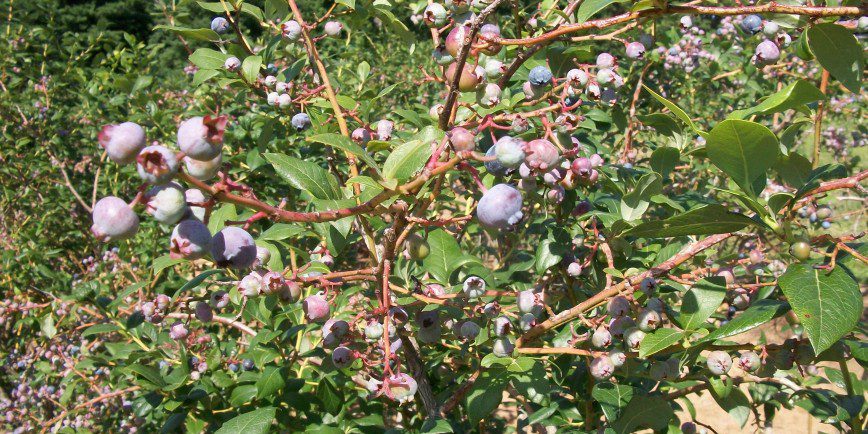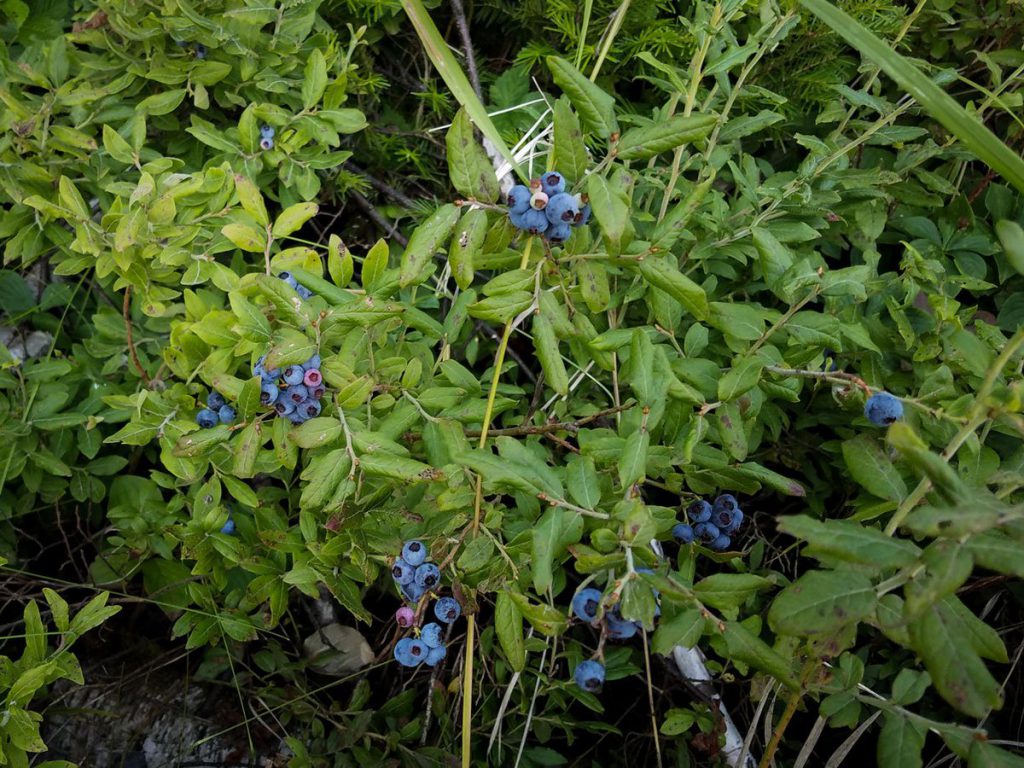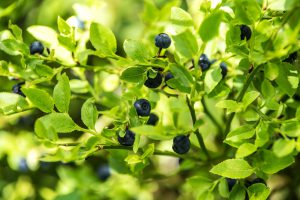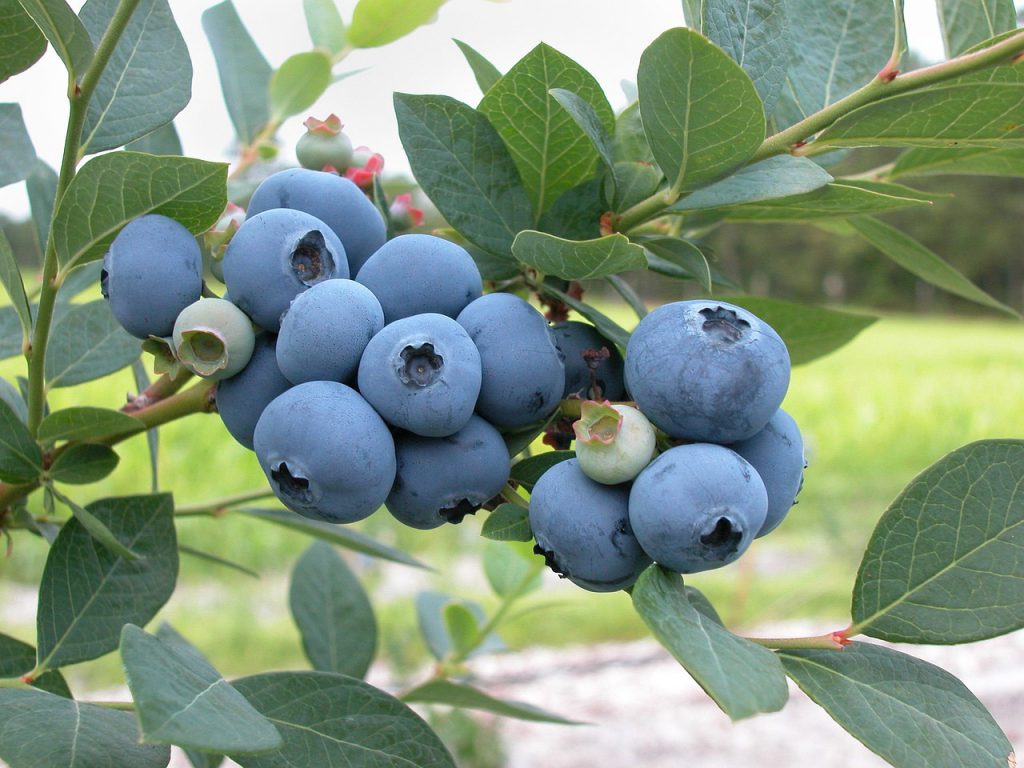Plant: Blueberry Bush
Soil Requirements: High Acidic Soil pH 4.5 – 5.5
Ideal Temperature: Depends on Varietal (Species)
Light Requirements: Full Sun
Watering Needs: Wet to Damp Soil
Time to Mature: 3 – 4 Years to Full Fruit
Harvest: 1 Bush Averages 20 – 30 lbs.
Starting Out
One of the first things your going to want to do is decide which variety of blueberry bush you want to grow. The amount of space, light, and temperature are going to have an impact on this decision. This question basically boils down to one big choice; Lowbush or Highbush? The difference between these two is pretty self-explanatory; one is a taller species than the other. There are crossbreeds and many mixtures but you should start out looking at what the overall spacial and care requirements are for the variety you are choosing to grow.
Once you know what your going to grow you now need to get some seeds and start germinating. Due to the extremely small size of blueberries, using the standard germinate before planting method will cause more difficulties then its worth. I like to use an old pepper shaker to evenly spread the tiny seeds across the sprouting media. If you are using a more standard sprout tray you may want to add 4-6 seeds per grow area.
One thing you need to be aware of is that all blueberry bushes need a more acidic soil to thrive. Most varieties develop best in a pH between 4.5 and 5.5 which is a good deal lower that most standard potting mix. To compensate for the extra pH needs your mix should contain about 35% Peat Moss. The added organic material will lower the pH. You can also use low pH premade soil. These soils can be advertised for azaleas, camellias, gardenias, hibiscuses, hydrangeas, orchids, or rhododendrons.

As with any fruiting plant your in it for the long haul. Blueberry plants will on average take 2-3 years to produce any fruit and much longer to produce a viable crop. Due to this you are going to want to choose a large strong container for your berry bush. I suggest using a pot that is 5 to 10 gallons or larger as blueberries require a lot of root space.
Basic Care
Blueberries plants generally need a very moist soil so when placed into a container it is very important to keep the plant well watered. I personally use Self Watering containers with almost all my plants which creates a very easy care situation. The reservoir base helps the plant to be a bit more hardy to dryer soil periods if you forget to water the plant. Adding a mulch layer to the top of the container can help to decrease the amount of evaporation that occurs allowing the soil to remain at optimal moisture for longer periods.
Adding a mulch layer can also serve a double purpose. Not only will it decrease the amount of evaporation that occurs but it can also help to maintain the pH of your container. As was stated earlier Blueberry plants are very acid needy. This creates a need to periodically check and manage your soil pH levels.
The best pH is somewhere between 4.5-5.5. There are a number of different methods you can use to regulate this throughout the growing process including: liquid fertilizers, crystal fertilizers, pH plant foods, and organic solutions as well. The most common additive is Cottonseed Meal. I’ve found that periodically using cottonseed meal with a mixture of pine bark and pine needle mulch works excellently.
One of the final and arguably most important pieces of care to consider is protecting your berries. If you are growing outside or even near an open window you need to consider adding a protection net for your planter. It is one of the worst feelings ever to reach your third year with a bush, patiently waiting your berries to develop, only to check one day and have your bush ravaged by birds, bears, raccoons, or other blueberry loving creatures. While I do not know what will stop a bear from stripping your bush, a simple chicken wire fence can protect it from most other hungry passersby.
Harvesting and Uses

Once the berries reach a bluish to reddish hue depending on species they are ready to pick and eat. When picking the berries from the bush you should support the branch where it meets the berry with one hand. You should then twist and pull the berry at the same time using your other hand. Fully ripened berries should come off very easily. If they do not come off easily you may want to consider waiting another 5 to 10 days before harvesting the rest of your berries.

Depending on the variety and maturity of your blueberry bushes they will produce different amounts of berries. Not only will you get different amounts from different varieties but the average size of berry produced by the different species varies greatly as well. Recipes involving berries are subject to some approximation so always use your best judgement on determining exact measurements of ingredients.
Fresh Blueberry Jam is super delicious and refreshing. One of the simplest treats you can make with an abundance of berries is jam. It takes about 4 cups of fresh berries to make a little under 2 cups of jam. Most recipes call for just blueberries, sugar, and lemon juice. Some recipes call for fruit pectin as well. The pectin helps to bind the jam and in my opinion is a point in taste as each has its place in the kitchen.
Fresh Blueberry Pies are absolutely amazing and are completely possible with just 4 cups of fresh blueberries. This is one of my favorite thing to do with a full harvest of blueberries. Berry pies are a great treat to add to your harvesting process. I usually make one at the beginning of my jam making process and use it as a reward for finishing making and jarring.
Freezing your excess berries after the season is a necessary step for most growers. The method of freezing fruits is very specific. The berries should be laid out flat on a tray and placed in the freezer for at least one hour. Once the berries have frozen in the trays they can’t be placed into a large freezer safe storage bag. If you skip this step you may as we’ll throw the storage bag way immediately next as you will end up with one solid frozen blueberry mash-cube. I’ve done it and ended up ruining the bag of fruit; I ended up with a frozen bag of mush. The berries need to be frozen individually before storing them together or they freeze and bond together.
There are a ton of different varieties but here are the main ones I have found:
Species: (alphabetically)
- Vaccinium alaskaense (Alaskan Blueberry)
- Vaccinium angustifolium (Lowbush Blueberry)
- Vaccinium boreale (Northern Blueberry)
- Vaccinium caesariense (New Jersey Blueberry)
- Vaccinium corymbosum (Northern Highbush Blueberry)
- Vaccinium constablaei (Hillside Blueberry)
- Vaccinium consanguineum (Costa Rican Blueberry)
- Vaccinium darrowii (Southern Highbush Blueberry)
- Vaccinium elliottii (Elliot Blueberry)
- Vaccinium formosum (Southern Blueberry)
- Vaccinium fuscatum (Black Highbush Blueberry)
- Vaccinium hirsutum (Hairy-Fruited Blueberry)
- Vaccinium koreanum (Korean Blueberry)
- Vaccinium myrsinites (Evergreen Blueberry)
- Vaccinium myrtilloides (Canadian Blueberry)
- Vaccinium operium (Cyan-Fruited Blueberry)
- Vaccinium pallidum (Dryland Blueberry)
- Vaccinium simulatum (Upland Highbush Blueberry)
- Vaccinium tenellum (Southern Blueberry)
- Vaccinium virgatum (Rabbiteye Blueberry)

This article is very rewarding about the blueberries. I like the photographs. I was going to ask you about intruders, like birds etc. but then you already answered that. Another question I like to ask you is the first year you plant the bush, how do you prepare it for winter? (because the bush being so young)
Hey,
Great question about wintering your plants is an important thing to consider. I only have 3 growing right now and all are different ages and in different sized containers. The bushes are all in movable containers and since I do not have that many I just bring them inside next to a large window for the winter and water them less once they begin to go dormant. If you do not have the option to bring them inside you can cover and wrap the container using mulch and burlap.
Hope this helps,
-Atlas
I am also into gardening and landscaping and what I found so amazing is how these plants are full of all that natural goodness. You have written an awesome post on blueberries and I am sure that your readers will love what you are sharing. Your post is very informative with a ton of good information.